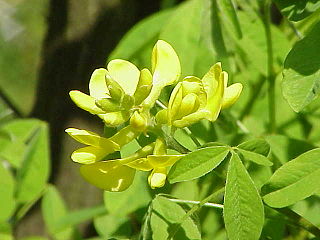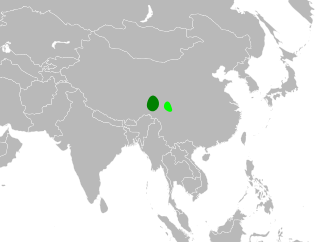
Petteria ramentacea, commonly known as Dalmatian laburnum, is a species of flowering plants in the family Fabaceae. It belongs to the subfamily Faboideae. It is the only member of the genus Petteria.

Argyrocytisus battandieri, the pineapple broom or Moroccan broom is a species of flowering plant in the legume family, Fabaceae, subfamily Faboideae. It is the only member of the genus Argyrocytisus.
Podocytisus caramanicus is a species of flowering plants in the family Fabaceae. It belongs to the subfamily Faboideae. It is the only member of the genus Podocytisus.

Dipteryx is a genus containing a number of species of large trees and possibly shrubs. It belongs to the "papilionoid" subfamily – Faboideae – of the family Fabaceae. This genus is native to South and Central America and the Caribbean. Formerly, the related genus Taralea was included in Dipteryx.
Neoharmsia is a genus of legume in the family Fabaceae.

Pericopsis is a genus of legume in the family Fabaceae.
Sakoanala is a genus of legume in the family Fabaceae. It contains two species which are endemic to Madagascar.

Adenolobus is a genus of African flowering plants in the legume family, Fabaceae. It belongs to the subfamily Cercidoideae.

Barklya is a genus of Australian trees in the legume family, Fabaceae. It belongs to the subfamily Cercidoideae. The sole species is Barklya syringifolia, commonly known as golden crown or golden glory. It grows in rainforest to 20 metres tall. Recorded from Queensland and New South Wales in rain forest. It is often used as an ornamental.
Baudouinia is a genus of flowering plants in the legume family, Fabaceae. It includes six species which are all endemic to Madagascar. It belongs to the subfamily Dialioideae.

Griffonia is a genus of central African flowering plants in the legume family, Fabaceae. It belongs to the subfamily Cercidoideae. Griffonia is known to have a high concentration of 5-HTP in its seeds.

Calicotome is a genus of flowering plants in the family Fabaceae. It includes five species native to the Mediterranean Basin. The genus belongs to the subfamily Faboideae. It may be synonymous with Cytisus. All species of the genus are thorny shrubs. The ancient Greeks believed that tyrants in Hades were punished by being beaten with the thorny calycotomes.
Gonocytisus is a genus of flowering plants in the family Fabaceae. It belongs to the subfamily Faboideae.

Hesperolaburnum platycarpum is a species of flowering plants in the family Fabaceae. It belongs to the subfamily Faboideae. It is the only member of the genus Hesperolaburnum.
Panurea longifolia is a species of flowering plants in the legume family, Fabaceae. It belongs to the subfamily Faboideae. It is the only member of the genus Panurea.
Petaladenium urceoliferum is a species of flowering plant in the family Fabaceae. It belongs to the subfamily Faboideae. It is the only member of the genus Petaladenium. It produces three chemical compounds in its leaves that are not found in other members of the Amburaneae: (2S,4S,5R)-5-hydroxy-4-methoxypipecolic acid, (2S,4R,5S)-5-hydroxy-4-methoxypipecolic acid, and (2S,4R,5R)-4-hydroxy-5-methoxypipecolic acid. Petaladenium urceoliferum is unique among legumes in having fimbriate–glandular wing petals.
Platycelyphium voense is a species of flowering plant in the family Fabaceae. It belongs to the subfamily Faboideae. It is the only member of the genus Platycelyphium.

Salweenia is a genus of flowering plants in the family Fabaceae. It belongs to the subfamily Faboideae.
Sellocharis paradoxa is a species of flowering plants in the family Fabaceae. It belongs to the subfamily Faboideae. It is native to Brazil and is the only member of the genus Sellocharis.
Spirotropis is a genus of flowering plants in the family Fabaceae. It belongs to the subfamily Faboideae.










